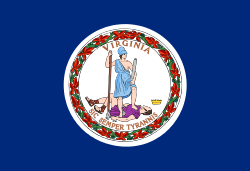Buckingham Branch Railroad
 | |
| Reporting mark | BB |
|---|---|
| Locale | Virginia |
| Dates of operation | 1989–present |
| Track gauge | 4 ft 8 1⁄2 in (1,435 mm) standard gauge |
| Headquarters | Dillwyn, Virginia |
Buckingham Branch Railroad (reporting mark BB) is a Class III short-line railroad operating over 200 miles (322 km) of historic and strategic trackage in Central Virginia. Sharing overhead traffic with CSX and Amtrak, the company's headquarters are in Dillwyn, Virginia in the former Chesapeake and Ohio Railroad (C&O) station, itself a historic landmark in the community. The railroad was featured in the January 2012 issue of Trains Magazine.
History
The tracks in the heart of Central Virginia which are now operated by the Buckingham Branch Railroad in the 21st century were mostly laid out in the 19th century by several railroad companies. These include the Louisa Railroad, the Virginia Central Railroad, the state-owned Blue Ridge Railroad (with famous tunnels designed by state engineer Claudius Crozet and financed by the Virginia Board of Public Works), and the Covington and Ohio Railroad. All of those lines became part of Collis Huntington's Chesapeake and Ohio Railroad (C&O) in the 1870s, which connected the Chesapeake Bay with the valleys of the New River and Kanawha River, leading to the Ohio River Valley and thence the Mississippi River.
In the 1880s, Major James H. Dooley's Richmond and Allegheny Railroad was built along the James River along the former right-of-way of the James River and Kanawha Canal. It too became part of the C&O, offering a lower grade pathway for coal bound from the mountains to Newport News than the older line through Staunton, Crozet's Blue Ridge Tunnel complex, and Charlottesville. Diverging from the older line at JD Cabin just east of Clifton Forge, this became known as the James River line, rejoining the old Virginia Central tracks near Main Street Station at Richmond.
The short-line branch from Bremo Bluff on the James River line into Buckingham County transported kaolin clay from the unique and rare deposits of Willis Mountain, along with timber, quarried rock, and minor amounts of general freight.
As major railroads merged and consolidated in the late 20th century, many rail lines with low traffic were abandoned, spun off into short-line railroads, or became at risk for abandonment. With lower operating costs and personalized service to shippers, many of the short-lines were able to perpetuate rail service in areas where the Class 1 railroads could not operate profitably, even when subsidized by government entities.
Buckingham Branch
The Buckingham Branch was founded in 1989 by retired CSX railroader Robert E. Bryant. The company began with the acquisition of a 16-mile (26 km) long branch from the CSX Transportation's James River subdivision line near Bremo Bluff on the James River south to Dillwyn in Buckingham County. The interchange with CSX is at Strathmore yard, near the junction of the former Virginia Air Line Railway. Serving small industries and quarries, the BBRR began with one locomotive, a caboose, and was staffed by Bryant's family.
-
BB 2, a GP16, getting a new coat of paint at Dillwyn, Virginia.
-
BBRR 4, an RS-4-TC, with a new coat of paint at Dillwyn, Virginia.
-
BB 7, a GP40, heading east at Louisa, Virginia.
-
BB 8, a GP16 in GRIV paint at Doswell, Virginia.
-

BB 13 switches Augusta CO-OP in Staunton, Virginia.
-

BB 7 with sisters, south on the Shenandoah Valley Railroad in Staunton, Virginia. Having just made a pick up of Empty Cars to take West.
Shenandoah Valley Railroad
For a number of years, the Buckingham Branch operated the Shenandoah Valley Railroad (SV) under contract. That short-line extends from Staunton through Augusta County north to Pleasant Valley outside Harrisonburg in Rockingham County. In 2002, the operating contract was lost to another Virginia-based short-line road, the Eastern Shore Railroad (ESHR). Today, the Shenandoah Valley Railroad, operated by the Durbin and Greenbrier Valley Railroad (DGVR), interchanges with the Buckingham Branch at Staunton.
-

This is a Photo of the NS interchange at Pleasant Valley, photo taken from the cab of Shenandoah Valley's GP38.
-
SV 40 GP9 is now the main motive power for SVRR.
-

SV 8701 is an RS4TC seen here in Verona.
CSX Piedmont, Washington, North Mountain subdivisions
In December 2004, Buckingham Branch entered into a 20-year lease with CSX Transportation to operate 200 miles (322 km) of track in Virginia on the latter's Piedmont, Washington, North Mountain subdivisions. Each were originally parts of the Virginia Central Railroad's line, and extend from Richmond through Doswell, Orange to Charlottesville, Virginia. From there, the line extends through the Blue Ridge Tunnel complex to Waynesboro, and Staunton to reconnect with CSX lines at Clifton Forge. The line which was the backbone of Collis Huntington's newly completed Chesapeake and Ohio Railroad in the 1870s was supplanted by a lower-grade line along the path of the former James River and Kanawha Canal in the 1880s.
Unlike the original branch in Buckingham County, the new section is leased for a 20-year period. CSX retains overhead trackage rights on the trackage leased to the Buckingham Branch, and continues its same pattern of running empty westbound coal and grain trains over the route, sometimes as many as 8 a day. Buckingham Branch train crews must contend with this fact by continually dodging the CSX westbounds, as well as the Amtrak trains, by going into the various sidings along the lines. Amtrak's Cardinal continues to use the Buckingham Branch line between Orange and Clifton Forge on Wednesdays, Fridays, and Sundays, the only instance where an Amtrak train utilizes a Class III railway line.
This new section of the expanded Buckingham Branch was dispatched by CSX from Jacksonville, Florida for the first two years, now it is dispatched by the BB out of Staunton.
